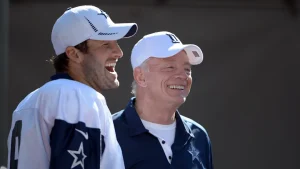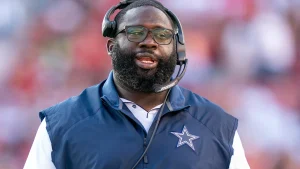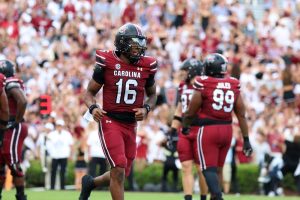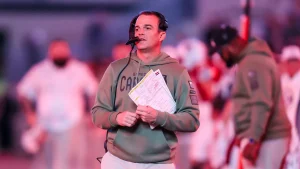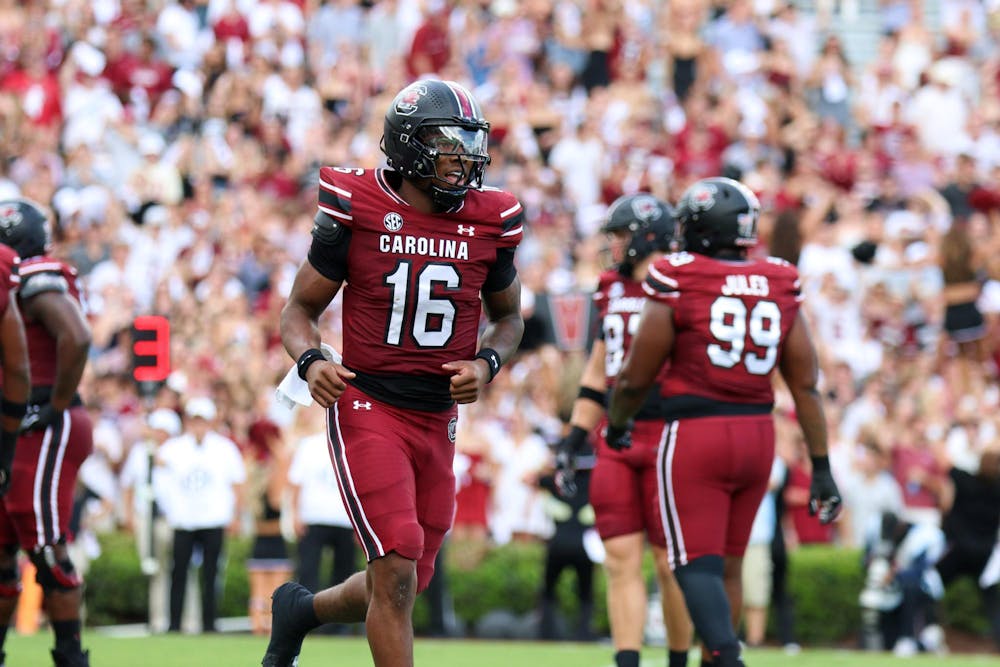
Sterling Sharpe has been inducted into the 2025 Pro Football Hall of Fame class.
Sterling Sharpe’s induction into the 2025 Pro Football Hall of Fame class represents a long-overdue recognition of one of the most dominant wide receivers to ever play the game. His inclusion into this prestigious group is a testament to his extraordinary career, which was tragically cut short but left an indelible mark on the NFL. Sharpe’s career—marked by breathtaking performances, unmatched consistency, and a competitive spirit—demands a closer look at his time in the league and why it took so long for him to receive the recognition he so rightfully deserves.
Early Life and College Career
Sterling Sharpe was born on April 6, 1965, in Chicago, Illinois. From a young age, it was clear that Sharpe possessed the physical traits and competitive drive that would set him apart in any sport. His athletic prowess was evident early on, and as a teenager, he was a star in multiple sports. However, it was football that eventually became his focus.
Sharpe attended Glenn Hills High School in Augusta, Georgia, where he showcased his skills as a standout wide receiver. His talents were apparent, but he was somewhat under-recruited compared to other players in the state. Despite this, Sharpe’s hard work and commitment to the game drew attention from scouts, and he went on to play college football at the University of South Carolina.
At South Carolina, Sharpe quickly made a name for himself as one of the top wide receivers in college football. Playing for the Gamecocks, Sharpe displayed his elite athleticism and ability to make plays in all situations. He was a versatile receiver, capable of making deep catches, running precise routes, and playing physical football. In his three years at South Carolina (1983–1987), Sharpe accumulated impressive statistics, including 169 receptions for 2,497 yards and 19 touchdowns.
Sharpe’s senior season in 1987 was particularly remarkable. He set several school records, including a single-season record for receiving yards, and was a consensus All-American. His dominance on the field earned him the reputation of one of the best wide receivers in college football, and by the time he declared for the NFL Draft, Sharpe had solidified his place as one of the top prospects at his position.
NFL Career: A Stellar, Short-Lived Journey
Sterling Sharpe was selected by the Green Bay Packers with the 7th overall pick in the 1988 NFL Draft. The Packers were coming off a disappointing season and were looking to inject some much-needed talent into their offense. Sharpe’s arrival in Green Bay was seen as a major boost for the franchise, and he would quickly prove to be everything the Packers hoped for and more.
From his rookie season, Sharpe made an immediate impact. In his first year in the NFL, he caught 55 passes for 1,174 yards and 3 touchdowns, earning a spot on the NFL All-Rookie Team. His performance was a glimpse into the remarkable career that lay ahead, and his potential to be one of the league’s top wide receivers was obvious.
The following seasons would see Sharpe’s dominance continue. In 1989, Sharpe set a Packers franchise record with 90 receptions, totaling 1,423 yards and 9 touchdowns. This season marked the beginning of a stretch of dominance that would define Sharpe’s career. His combination of speed, agility, physicality, and hands made him a nightmare for opposing defenses. He was a constant threat on the field, capable of making plays at any moment, whether through spectacular catches or precise route running.
One of the most impressive aspects of Sharpe’s game was his consistency. Over the next few seasons, Sharpe continued to put up incredible numbers. In 1992, he led the NFL with 18 touchdown receptions and was named an All-Pro for the fourth consecutive year. His ability to create separation from defenders, as well as his knack for finding the end zone, made him one of the most feared receivers in the league. He was an integral part of the Packers’ offense during this period, forming a deadly connection with quarterback Brett Favre, who had become the face of the franchise.
Sharpe’s peak years came between 1991 and 1994, when he earned five consecutive Pro Bowl selections and was named an All-Pro four times. In 1994, he posted his career-best numbers: 112 receptions for 1,461 yards and 18 touchdowns. He led the NFL in receiving touchdowns for the second time in his career and solidified his status as one of the best in the business. Sharpe’s ability to excel in high-pressure situations also stood out, as he frequently made critical catches in clutch moments, demonstrating his poise and mental toughness.
However, despite his dominance on the field, Sharpe’s career was not without its challenges. One of the biggest obstacles he faced was the struggle to achieve sustained team success. While Sharpe consistently put up phenomenal individual numbers, the Packers as a team struggled to break through in the postseason. They made the playoffs in 1993, but Sharpe’s hopes of winning a Super Bowl remained elusive.
The Heartbreaking End of a Promising Career
In 1994, Sterling Sharpe was forced to retire prematurely at the age of 29 due to a neck injury. What could have been one of the greatest wide receiver careers in NFL history was cut short, leaving fans, analysts, and teammates in disbelief. Sharpe’s retirement was a heartbreaking moment for the league, as it came at the height of his career when he was still playing at an elite level.
Sharpe’s decision to retire stemmed from the ongoing neck injuries that plagued him throughout his career. Despite his success and continued ability to play at a high level, doctors advised Sharpe that the risk of permanent damage was too great if he continued playing. Although it was devastating for Sharpe to walk away from the game he loved, he made the responsible choice to prioritize his long-term health and well-being.
In his short career, Sharpe had already established himself as one of the best wide receivers in NFL history. He had amassed 595 receptions, 8,134 yards, and 65 touchdowns in just eight seasons. His 18 touchdown receptions in 1994 remained a Packers franchise record until 2014. Sharpe’s dominance on the field, especially during the peak of his career, was undeniable, and his retirement left a massive void in Green Bay’s offense.
The Legacy of Sterling Sharpe
Sterling Sharpe’s legacy is multifaceted. Despite playing in an era with other wide receivers who achieved significant success—such as Jerry Rice, Michael Irvin, and Cris Carter—Sharpe’s name still stands out among the best of his time. His stats, his impact on games, and his consistency over his brief career speak to his greatness.
Sharpe’s contributions to the Green Bay Packers, however, go beyond just his statistics. He helped transform the Packers into a competitive team during the late 1980s and early 1990s, providing the offense with a legitimate playmaker. His influence on the development of quarterback Brett Favre cannot be overstated. The chemistry between Sharpe and Favre was immediate, and it became one of the most dynamic duos in the NFL at the time. Favre, who would go on to become a Hall of Fame quarterback, often spoke highly of Sharpe, praising his route-running ability and his ability to make critical plays in key moments.
Sharpe’s impact on the NFL went beyond the field as well. His style of play, characterized by toughness and resilience, became an inspiration to a new generation of wide receivers. His no-nonsense approach to the game, paired with his mental toughness and dedication, set the standard for wide receivers to come. Players like Terrell Owens, Randy Moss, and others would cite Sharpe’s ability to dominate in all aspects of the game as a model for success.
Despite his early retirement, Sharpe’s legacy remained strong in the hearts of Packers fans, many of whom still regard him as one of the greatest to ever wear the Green and Gold. The franchise continued to build on the foundation Sharpe helped establish, eventually winning Super Bowl XXXI in 1997, a title that many believed Sharpe deserved to be a part of.
The Hall of Fame Recognition
The decision to induct Sterling Sharpe into the Pro Football Hall of Fame in 2025 is a momentous occasion that honors his incredible career and the lasting impact he had on the game of football. While Sharpe was often overshadowed by other legendary wide receivers during his playing days, his induction solidifies his place among the greatest to ever play the position.
For many years, Sharpe was left out of the Hall of Fame conversation, despite his impressive stats and undeniable talent. His relatively short career, which didn’t include a Super Bowl ring, was often cited as a reason for his exclusion. However, time and recognition of his dominance during his brief career have ultimately led to his inclusion in the Hall of Fame.
Sharpe’s Hall of Fame induction is a tribute not just to his individual accomplishments, but also to the resilience and determination he exhibited throughout his career. His legacy is defined by his ability to transcend the challenges that came his way—whether those challenges were injuries or the limitations of playing in an era with other great receivers. The fact that Sharpe was able to make such a lasting impact in such a short time speaks volumes about his talent and work ethic.
Sterling Sharpe’s induction into the Pro Football Hall of Fame in 2025 is an overdue but well-deserved acknowledgment of one of the NFL’s greatest wide receivers. Despite a career that was tragically shortened by injury, Sharpe’s contributions to the game cannot be overlooked. His stats, his influence on the Packers’ offense, and his overall impact on the NFL make him a true legend of the game. His induction is a reminder that greatness is not always measured by the length of a career, but by the legacy a player leaves behind. Sterling Sharpe’s legacy is one of unparalleled talent, toughness, and an enduring love for the game of football.

